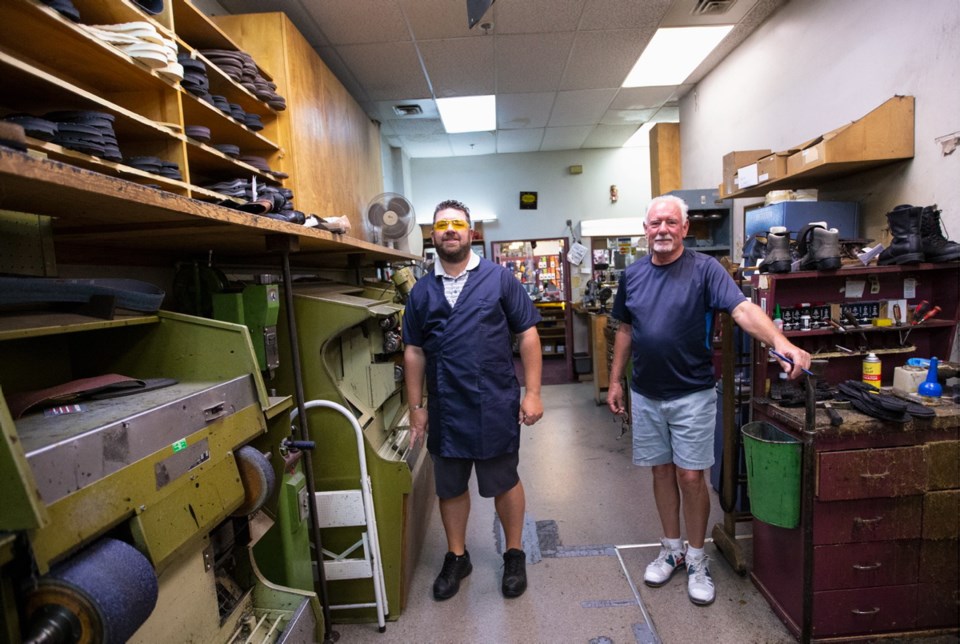Businesses in Victoria’s downtown core have weathered recessions, corrections and bike lanes, but some might not survive the work-from-home trend.
Because of the COVID-19 pandemic, government offices and Crown agencies have directed the bulk of their staffs to work from home for the foreseeable future, and many private-sector employers have done the same.
That has drastically changed traffic patterns and the sheer number of people on downtown streets, and it has some business owners wondering what their futures will look like.
“We definitely notice the lack of office workers,” said Michele Byrne, one of the owners of the Dutch Bakery, which has been in business downtown for 64 years. “We have had a few of our office regulars come in, but I think a lot of them are working from home.”
That’s meant a massive drop in walk-in traffic, breakfast and lunch business and people popping in to grab dessert on the way home.
Byrne said they have trimmed their staff levels considerably, have only a third of their diner open and are focusing on baking only the most popular items.
They have also increased their online presence, which has translated into decent sales.
Byrne wonders if there will be more difficult decisions to be made if the number of people working downtown never returns to previous levels.
“It’s a concern that they might not come back — we see them working from home and we had already seen some offices relocating to spaces outside the city,” she said, adding it’s just another hit for downtown, which already has to deal with perceptions about a lack of parking and homeless people on the street.
“We have taken hits over the years, so losing office workers and tourists this year will be huge.”
John Phillion, owner of Stevenson’s Shoe Clinic, which has been in business downtown since 1925, describes his daily walk from the parkade on Broughton Street to his store on Fort Street as desolate, with near-empty office buildings and quiet lanes.
Phillion, who has worked at his family’s shop for 47 years, said fewer people downtown has affected his business, which is likely to feel the sting if the work-from-home trend continues.
“You can argue people won’t be wearing dress shoes when working from home,” said Phillion. “There is a certain amount of people we will miss.”
One advantage is that the Shoe Clinic is a destination store, he said.
“There’s not too many of us left doing this trade, so if you do need us or have been a customer in the past, you make a more concerted effort to get here,” he said. “But we have been affected. There’s no doubt.”
It’s not all bad, though, he quipped. “The parking lots will be more accessible.”
Dale Olsen, owner of Outlooks for Men clothing store on Yates Street, anticipates long-term changes, such as workers going into the office just two or three days a week instead of five.
Olsen said on top of reduced foot traffic, the pandemic could signal the death of the suit, as people working from home won’t feel the need to dress up every day.
“That’s the beauty of being me, independent — I’m not Moore’s the Suit People,” he said, noting he can pivot and easily change inventory to cater to whatever the new business-office normal is.
But Jeff Bray, chief executive of the Downtown Victoria Business Association, is confident the novelty of working from home will wear off soon, arguing people are missing the social side of work.
Bray said the DVBA is pushing the province to model guidelines for having people, where appropriate, return to work at their offices. “A lot of small businesses were built up in part by having those office workers in the neighbourhood five days a week.
“Even if we had 50-60 per cent of people back, that could make the difference in some small businesses’ survival. It’s critical because we won’t have the tourists this year.”
According to the province, which represents a broad swath of downtown office space, public-service workplaces are expected to continue operating with reduced occupancy to allow for social distancing.
Some employees are working from home if they can, while some offices have been expanded and reconfigured to allow more workers to return to the ministry buildings, while maintaining distancing.
Kris Montanini, commercial furniture specialist with Monk Office, said they have been busy sourcing items such as plastic shields and larger desks and work stations, which allow for physical distancing.
He noted many projects that would have seen offices reconfigured to make the best use of space have now been cancelled, as companies and government have to keep people separated.
Sandra Lyle-Mason, interior designer with Gabriel Ross Contract, which designs offices, said at the outset of the pandemic, they were fielding orders for ergonomic chairs and tables for people newly working from home who were trying to make do with kitchen tables and chairs.
Now, she said, they are working with larger companies to redesign floor plans.
“It’s a really big pivot in interior design right now,” she said. “The trend had been collaborative work spaces, smaller footprints and densifying the floor plate — so computers got smaller and desks got smaller.
“Now it’s a focus on private offices, making work spaces bigger, and we’re seeing demand in glass walls and partitions.”
Bray said he’s already starting to see more office workers in the core and hopes that continues.
So does Byrne, who said the last week has actually been good for the bakery. “Maybe it’s turning around a little — people do seem to be opening up a bit,” she said. “It’s going to be interesting to see how this turns out.”



